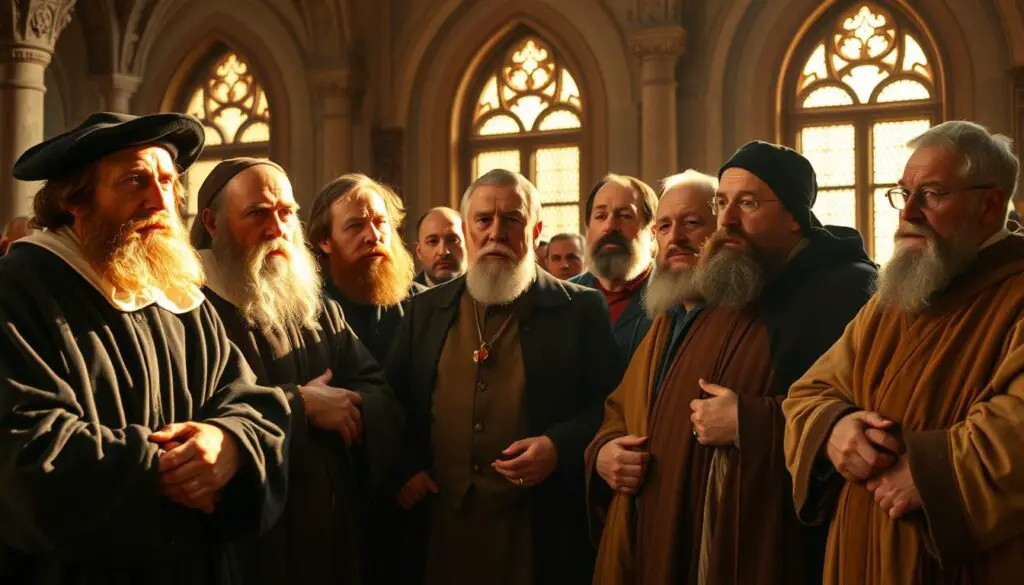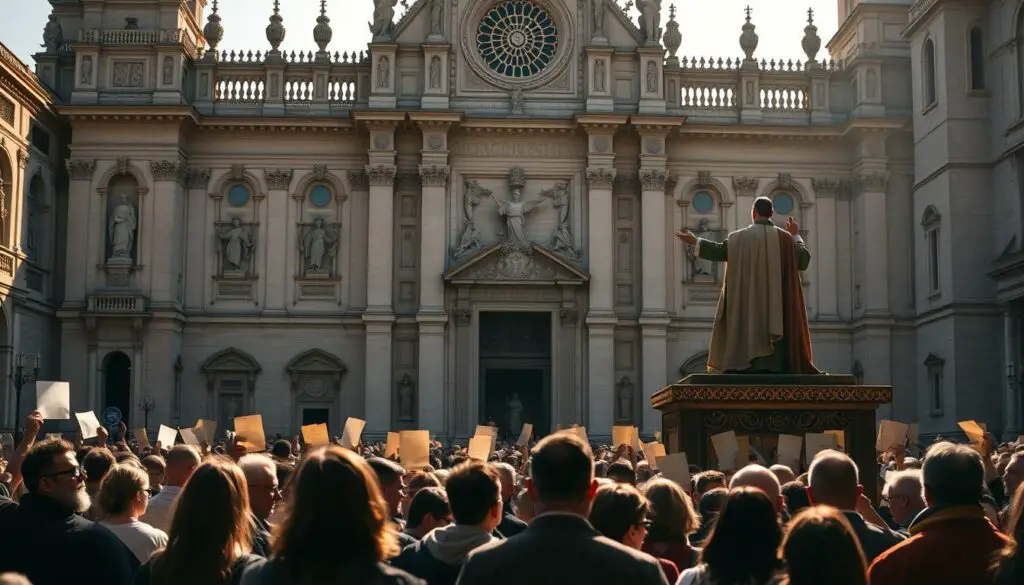Imagine a single document reshaping global religion forever. That’s exactly what happened when a German monk named Martin Luther sparked a spiritual earthquake in 1517. His bold critiques of church practices ignited a movement that would divide Western Christianity and create lasting change across Europe.
This historical shift wasn’t just about theology—it rewrote society’s rules. Leaders like Luther and John Calvin argued that personal faith mattered more than institutional rituals. Their ideas spread like wildfire through new printing technology, challenging centuries of tradition.
The ripple effects reached far beyond Sunday services. Entire nations reconsidered their relationships with religious authority. Ordinary people gained access to scripture in their own languages, while rulers used these changes to strengthen political power. Even modern concepts like individual rights trace some roots to this era.
Why does this 500-year-old movement still matter? Its legacy lives on in diverse Christian traditions and cultural values. From Bible study groups to constitutional governments, the Reformation’s emphasis on personal conviction continues shaping our world today.
Key Takeaways
- Began with Martin Luther’s 1517 challenge to church practices
- Introduced the revolutionary idea of salvation through faith alone
- Used new printing technology to spread ideas rapidly
- Created lasting political and social changes across Europe
- Influenced modern concepts of individual religious freedom
Historical Background and Context of the Reformation
The 16th century dawned with religious institutions holding unprecedented sway over daily life. Europe’s spiritual leaders sat at the intersection of faith and governance, their decisions shaping kingdoms and commoners alike.
The Late Medieval Church Landscape
By 1500, the Catholic Church controlled vast lands and influenced royal successions. Its alliance-building with rulers created a power network stretching from Rome to Scandinavia. But this political web came at a cost:
| Church Interests | State Interests | Conflict Points |
|---|---|---|
| Tax exemptions | National treasuries | Wealth distribution |
| Papal authority | Royal sovereignty | Legal jurisdiction |
| Indulgence sales | Public trust | Spiritual credibility |
Local priests often sold forgiveness certificates called indulgences. A German bishop famously claimed these slips could “open the gates of heaven itself.” Such practices made many question where true authority resided.
Political and Social Conditions in Europe
Kings eyed church lands hungrily, while merchants resented religious taxes. Three key factors fueled discontent:
- Growing literacy rates among city dwellers
- Rising nationalist sentiments in kingdoms
- Public anger over clergy privileges
Urban markets buzzed with translated Bible excerpts, thanks to printing presses. For the first time, bakers and blacksmiths could debate scripture without priestly mediation. This shift would prove revolutionary.
Key Figures and Influential Reformers
Behind every revolution stand visionaries who dare to challenge norms. The spiritual upheaval of the 1500s introduced unforgettable leaders whose ideas rewrote religious history. Their combined efforts created lasting change across continents.
Martin Luther’s Role and Legacy
A fiery Augustinian monk named Martin Luther lit the fuse in 1517. His 95 Theses nailed to a church door questioned church practices with academic precision. “Why does the pope’s wealth surpass that of any prince?” he famously asked.

Luther’s dual role as teacher and preacher gave him unique influence. He translated scripture into German while defending his theses before emperors. This monk-turned-rebel proved one voice could shake empires.
John Calvin and Other Pioneers
French thinker John Calvin brought structure to the chaos. His 1536 Institutes became Protestantism’s first textbook. Three key features defined his approach:
- Emphasis on God’s ultimate authority
- Clear church governance models
- Predestination theology
England’s Henry VIII took a different path. His 1534 break with Rome created the Anglican Church through royal decree. Meanwhile, Swiss reformers like Huldrych Zwingli reshaped worship practices city by city.
These diverse leaders shared one trait: unwavering conviction. From university halls to royal courts, their actions still echo in modern faith traditions.
Exploring the Protestant Reformation Meaning
What if your entire understanding of God could fit in your hands? This radical idea became reality when reformers reshaped Christianity’s core principles. Their theological breakthroughs challenged centuries of established beliefs, putting scripture and personal conviction at the center of spiritual life.
Theological Shifts and Doctrinal Challenges
Martin Luther’s revolution began with ink and parchment. While earlier critics targeted church corruption, he declared: “Salvation comes through faith alone—not deeds or donations.” This sola fide principle upended traditional views of divine grace, suggesting anyone could connect directly with God.
Three seismic changes redefined Christian doctrine:
| Catholic Teachings | Reformers’ View | Key Difference |
|---|---|---|
| Scripture + Tradition | Bible alone guides | Source of truth |
| Faith + Works | Faith suffices | Path to salvation |
| Clergy mediation | Personal connection | Spiritual access |
John Calvin expanded these ideas, blending faith with structured community laws. His focus on predestination contrasted with Luther’s emphasis on individual redemption. Yet both agreed: scripture outweighed human tradition.
These teachings transformed worship practices. Congregations began singing in common languages, while laypeople debated biblical texts. The changes created diverse denominations—each interpreting these core principles differently.
Today, these 16th-century theology debates still shape church services worldwide. From Bible study groups to sermon-centered worship, the emphasis on personal engagement remains a living legacy.
The Catholic Church, Indulgences, and Corruption
What if buying forgiveness became as common as buying bread? This shocking reality defined early 16th-century Europe, where spiritual promises carried price tags. The Catholic Church‘s system for managing sin created both hope and outrage, fueling debates that would alter history.

Abuses Within the Church Structure
Traveling salesmen of salvation called quaestores roamed towns with parchment in hand. Their pitch? “Purchase reduced time in purgatory for yourself or deceased loved ones.” Church-approved formulas claimed:
| Official Doctrine | Street Sales Pitch | Reality |
|---|---|---|
| Reduce purgatory time | “Guaranteed heaven entry” | False promises |
| Donation-based | “Pay or face damnation” | Fear tactics |
| Local use of funds | “Support Rome’s projects” | Personal profits |
One pardoner reportedly declared: “When coins in the chest ring, souls from fire spring!” Such theatrics turned sacred rituals into market transactions.
The Impact of Indulgences on Public Perception
Farmers began questioning why the pope needed gold while their children went hungry. Stories spread of priests living lavishly on indulgence profits. Three critical shifts occurred:
- Scripture-literate citizens noticed discrepancies
- Local leaders challenged Rome’s financial demands
- Average believers doubted clergy’s spiritual motives
As one German woodcutter asked: “If God forgives through coins, what value has faith?” This erosion of trust would prove irreversible, planting seeds for widespread change.
The Spread of Reformation Movements Across Europe
Map borders redrew as spiritual revolutions swept Europe. By 1550, over 200 cities had embraced new religious ideas. Local rulers often determined their territories’ faith – a trend reshaping both worship and governance.

Lutheranism, Calvinism, and the Anglican Shift
Northern kingdoms found political advantage in Luther’s teachings. Denmark’s king Christian III confiscated church lands in 1536, declaring: “Our crown and conscience align with God’s true word.” This pattern repeated across Scandinavia:
| Region | Dominant Faith | Key Figure | Political Catalyst |
|---|---|---|---|
| Germany | Lutheranism | Elector Frederick | Resistance to papal taxes |
| Scotland | Presbyterianism | John Knox | Noble opposition to French influence |
| England | Anglicanism | Thomas Cranmer | Royal supremacy claims |
Eastern Europe became a laboratory for radical ideas. Weak monarchies allowed nobles to shelter diverse groups. Anabaptists and Unitarians thrived where central control faltered.
Geneva transformed into a Protestant powerhouse under Calvin. His academy trained 1,200 ministers in 25 years. Exiles carried these teachings to France’s Huguenots and Dutch Reformers.
The Church of England charted its own course. Henry VIII kept cathedral spires but replaced Latin liturgies with English prayers. This hybrid approach satisfied those wary of Rome yet attached to tradition.
Southern Europe resisted change fiercely. Spanish inquisitors rooted out “heretics,” while Italian city-states reinforced Catholic identity. These divisions still echo in modern religious landscapes.
Innovations in Religious Thought and Practice
What if every answer you sought lay within a single book? This simple idea became revolutionary when 16th-century thinkers declared scripture the ultimate authority for spiritual life. Their radical approach reshaped how people practiced faith across continents.
Scripture as the Ultimate Guide
Reformers tossed out centuries of accumulated traditions, insisting the Bible alone held truth. As Luther argued: “God’s word needs no interpreter – it speaks plainly to willing hearts.” This doctrine of sola scriptura sparked dramatic changes:
| Catholic Practice | Protestant Innovation | Impact |
|---|---|---|
| Latin Bible readings | Vernacular translations | Accessible worship |
| Priestly interpretation | Personal study | Individual connection |
| Sacramental rituals | Simplified services | Focus on teaching |
New Bible versions flooded markets. Farmers could now debate scripture like scholars. This shift created diverse teachings – Luther emphasized grace through faith, while Calvin focused on divine sovereignty.
Anabaptists took radical steps, rejecting infant baptism. Their way of life emphasized community over hierarchy. These differences show how one doctrine birthed multiple traditions.
Worship transformed too. Congregations sang hymns in common languages. Pulpits replaced altars as teaching became central. These changes laid the basis for modern theology that values personal engagement with scripture.
Political, Social, and Economic Impacts of the Reformation
The spiritual revolution reshaped more than Sunday services—it redrew Europe’s power maps. As authority shifted from altars to thrones, rulers seized church lands and rewrote laws. This seismic change sparked both progress and chaos across generations.
Power Shifts Between Church and State
Princes found new leverage in religious debates. Many German leaders used reformist ideas to resist imperial control, turning faith into a political weapon. The catastrophic Thirty Years’ War (1618-1648) showed the cost—entire regions lost 40% of their people.
Economic Consequences and Cultural Change
Monasteries became royal property overnight, funding new state projects. A fresh work ethic emerged, linking daily life to spiritual purpose. Families gained control over marriage laws, while schools multiplied to teach scripture reading.
These changes didn’t come quietly. Violent conflicts lasted decades, yet planted seeds for modern governance. Today’s separation of church and state owes much to this turbulent era’s hard-won lessons.
FAQ
What sparked Martin Luther’s criticism of the Catholic Church?
Luther opposed practices like selling indulgences, which promised reduced time in purgatory for payment. He believed salvation came through faith and grace, not monetary transactions or human works.
How did political leaders influence the spread of Reformation ideas?
Rulers like Henry VIII in England used religious reforms to challenge the Pope’s authority and gain control over land, taxes, and legal systems. This shifted power from the Church to the state in many regions.
Why was sola scriptura a revolutionary concept?
A: Sola scriptura (“Scripture alone”) emphasized the Bible as the sole source of religious authority, rejecting extra-biblical traditions. This empowered individuals to interpret texts personally, weakening the clergy’s exclusive role.
How did John Calvin’s teachings differ from Luther’s?
Calvin focused on predestination, the idea that God preordains salvation. His structured approach to theology and governance influenced movements like Puritanism and shaped communities like Geneva.
What role did corruption play in weakening the medieval Church?
Scandals like simony (selling church offices) and absentee bishops eroded public trust. Critics argued leaders prioritized wealth and power over spiritual guidance, fueling demands for reform.
How did the Anglican Church originate?
Henry VIII broke from Rome after the Pope denied his request to annul his marriage. The 1534 Act of Supremacy declared the English monarch head of the new Anglican Church, blending Catholic traditions with Protestant ideas.
What long-term cultural changes came from the Reformation?
It encouraged literacy through vernacular Bibles, reshaped education, and sparked debates about individual rights. These shifts laid groundwork for modern concepts of democracy and personal freedom.
Why do Reformation-era conflicts still matter today?
Issues like the balance between religious authority and secular governance, or debates over doctrine versus personal conscience, continue to influence global discussions on ethics, law, and human rights.